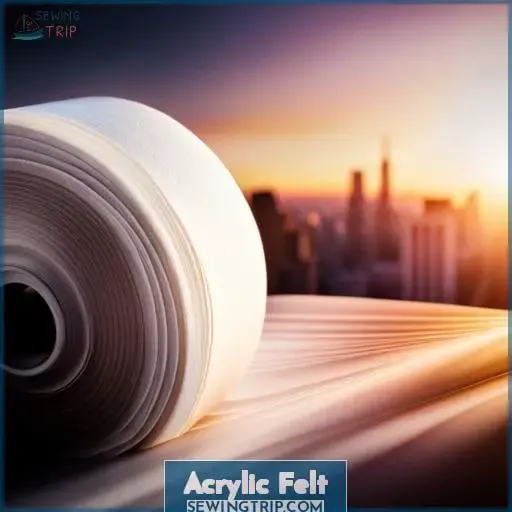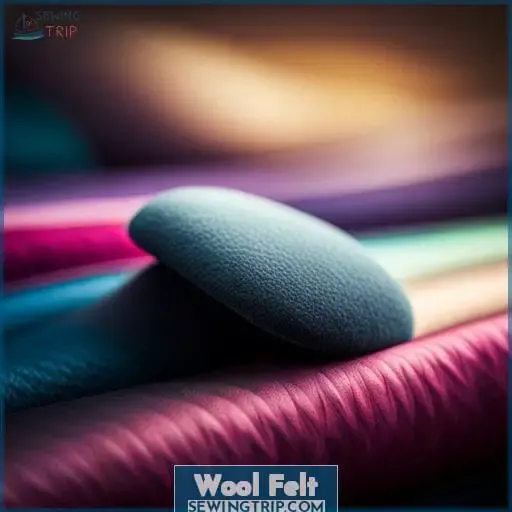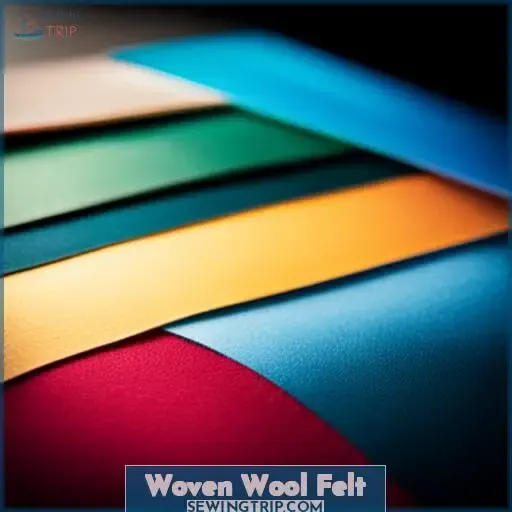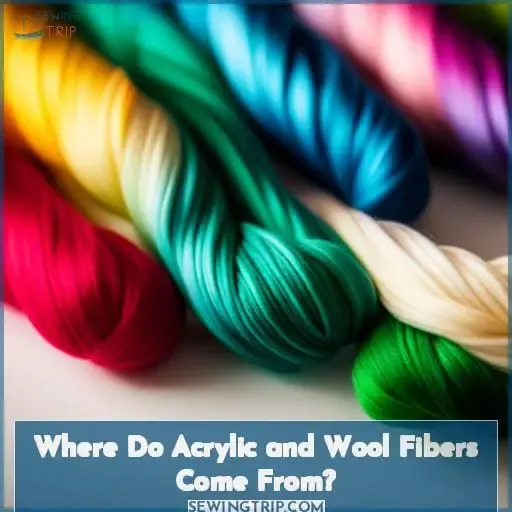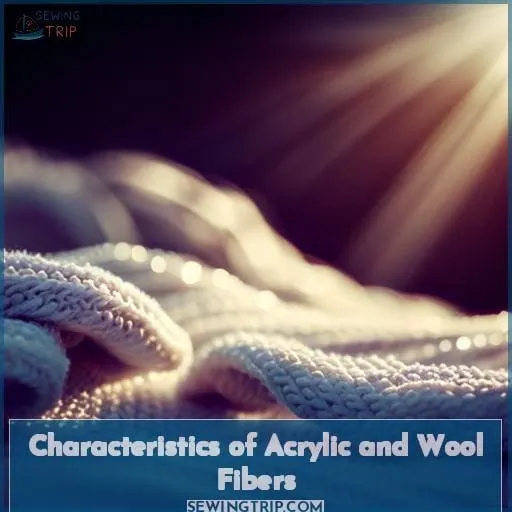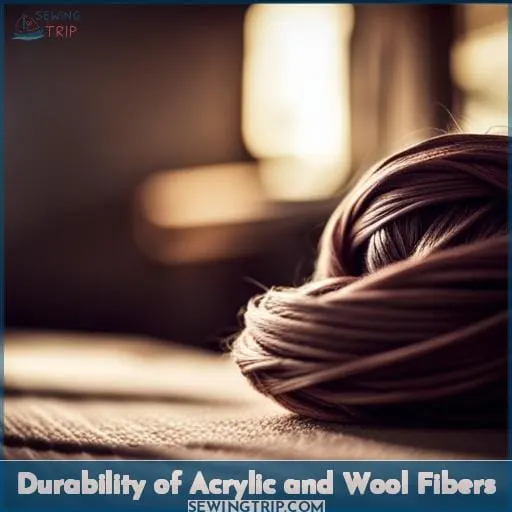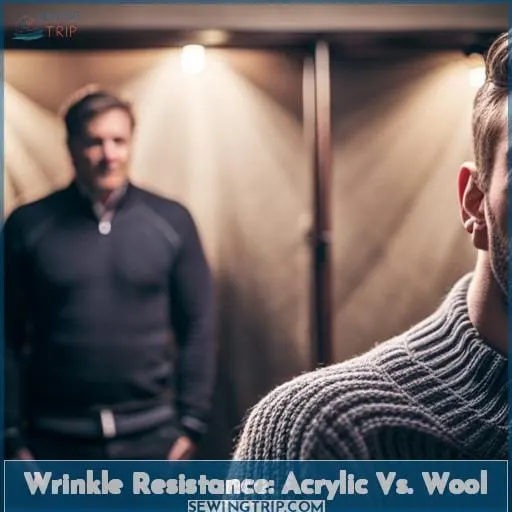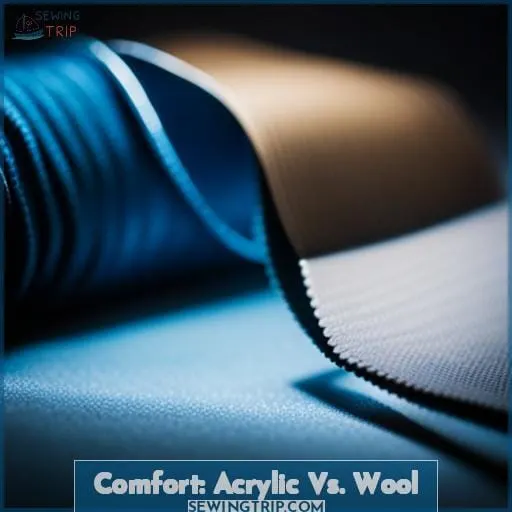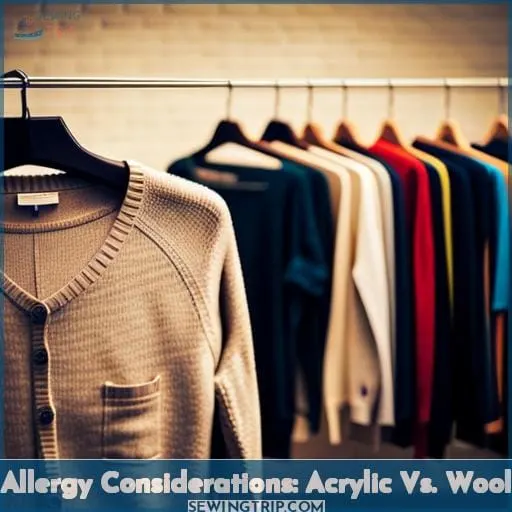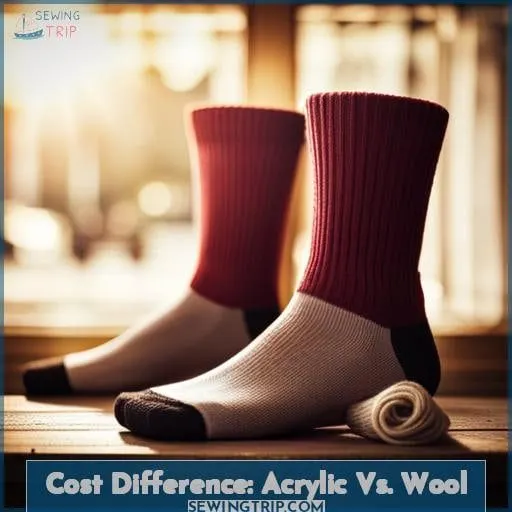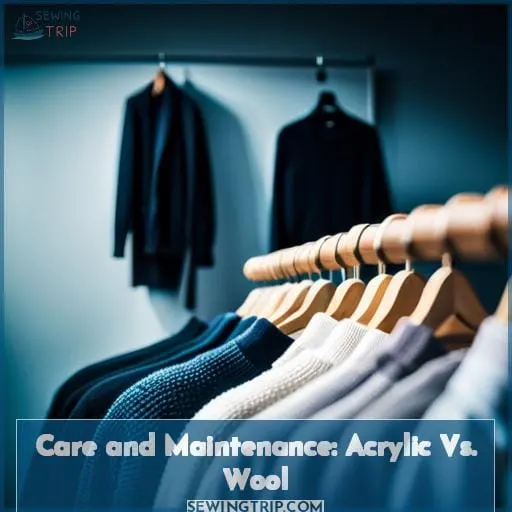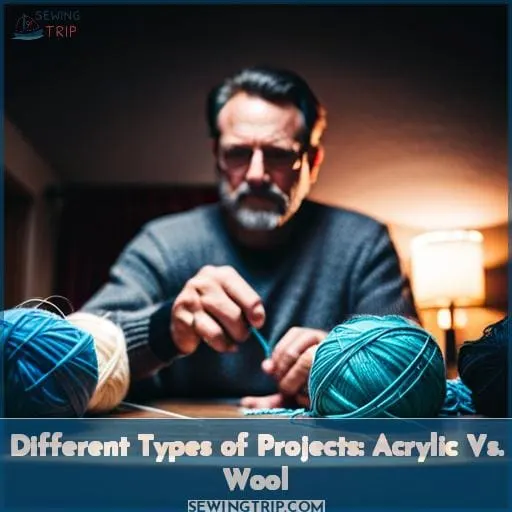This site is supported by our readers. We may earn a commission, at no cost to you, if you purchase through links.
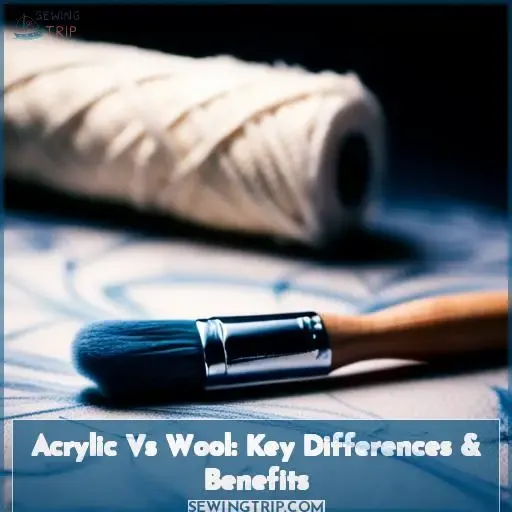 Imagine you’re standing in front of a rack of sweaters, trying to decide between acrylic and wool. You want something that’s durable, comfortable, and fits your budget. Well, look no further! In this article, we’ll explore the key differences and benefits of acrylic vs wool fabrics.
Imagine you’re standing in front of a rack of sweaters, trying to decide between acrylic and wool. You want something that’s durable, comfortable, and fits your budget. Well, look no further! In this article, we’ll explore the key differences and benefits of acrylic vs wool fabrics.
Whether you’re a textile engineer or simply love cozy clothing options, understanding these materials will empower you to make the right choice for your next project or wardrobe upgrade.
Table Of Contents
- Key Takeaways
- Acrylic Felt
- Wool Felt
- Woven Wool Felt
- Where Do Acrylic and Wool Fibers Come From?
- Characteristics of Acrylic and Wool Fibers
- Durability of Acrylic and Wool Fibers
- Wrinkle Resistance: Acrylic Vs. Wool
- Comfort: Acrylic Vs. Wool
- Allergy Considerations: Acrylic Vs. Wool
- Cost Difference: Acrylic Vs. Wool
- Care and Maintenance: Acrylic Vs. Wool
- Different Types of Projects: Acrylic Vs. Wool
- Frequently Asked Questions (FAQs)
- Conclusion
Key Takeaways
- Acrylic is less absorbent than wool.
- Wool is more durable than acrylic.
- Acrylic is more wrinkle-resistant than wool.
- Wool tends to be more comfortable next to the skin than acrylic.
Acrylic Felt
Acrylic felt is a versatile fabric option for various crafting projects. It offers a wide range of benefits and considerations to keep in mind.
Firstly, acrylic felt is widely available, making it easily accessible for your creative endeavors. Additionally, it comes in an extensive array of colors, allowing you to unleash your imagination and create vibrant designs.
In terms of price, acrylic felt is the most budget-friendly choice compared to wool or woven wool felts.
When it comes to strength and durability, however, acrylic felt may not be as robust as its counterparts. While suitable for projects that won’t be handled much or require a long lifespan like holiday decorations or card making; if you’re looking for something more resilient such as heirloom pieces or applique on quilts that can withstand wear and tear over time – wool felts would serve better.
In terms of care and maintenance requirements are concerned with acrylic felt needs special attention since they can’t be washed or laundered due their composition while wool felts can endure dry cleaning procedures but should take precautions when washing at home regarding color bleeding risks.
Lastly allergies could also come into play here: some individuals may have allergic reactions towards certain fibers used in manufacturing these fabrics , so considering this aspect before beginning any project involving yarns/fibers becomes essential.
Wool Felt
Now that you have learned about acrylic felt and its various characteristics, it’s time to delve into the world of wool felt. Wool felt is a versatile fabric with unique properties that set it apart from other materials.
- Thickness and Density: Wool felt is known for its thickness and density, which provide a substantial texture ideal for projects requiring depth and structure.
- Durability for Projects: When it comes to durability, wool felt surpasses many other fabrics. It can withstand heavy use in projects such as heirloom quilts or applique work that requires long-lasting strength.
When caring for your project made with this luxurious material, proper maintenance includes regular spot cleaning using mild detergent solutions without submerging them completely in water since excessive moisture may cause shrinkage or distortion.
Woven Wool Felt
When working with woven wool felt, you’ll find that it offers a thicker and denser texture compared to other types of felts. This makes it an excellent choice for various projects that require a thick texture, such as pincushions or other crafts where durability is important.
Woven wool felt comes in a range of colors, allowing you to choose the perfect shade for your project. However, due to its unique qualities and production process, woven wool felt can be harder to find than acrylic or regular wool felts.
In terms of price, woven wool felt falls within the same range as traditional wool felts. While it may be slightly more expensive than acrylic options on the market, its superior quality and durability make it worth considering for projects that require long-lasting results.
To maintain your woven wool felt items in optimal condition over time requires some care and attention. It’s recommended to hand wash them using mild detergent specifically designed for delicate fabrics like wools or fibers with similar characteristics.
Overall, Premium-quality materials like 100% virgin merino sheep’s have been used extensively by textile engineers who design top-quality products at affordable prices ensuring wrinkle-resistance combined with great moisture-wicking properties; hence making this fabric ideal not only from an aesthetic standpoint but also practicality-wise when creating masterpieces out of durable textiles.
Where Do Acrylic and Wool Fibers Come From?
You may be wondering where exactly acrylic and wool fibers come from.
Acrylic fibers are synthetic, meaning they’re man-made rather than occurring naturally. These fibers are typically derived from substances such as acrylonitrile or polyacrylonitrile.
On the other hand, wool is a natural fiber that comes from the fleece of sheep. It’s sheared off the animal’s body and then processed to create yarn or fabric.
The process of obtaining acrylic fibers involves chemical processes in order to create a material that closely resembles natural wool but at a lower cost. Wool production, on the other hand, requires raising sheep and carefully harvesting their fleece without causing harm to the animals.
Both types of materials have distinct characteristics when it comes to durability, care requirements, comfort levels, and price points. Understanding where these fabrics originate can provide valuable insight into their properties as well as help you make informed decisions about which one would best suit your needs for different projects or applications.
Characteristics of Acrylic and Wool Fibers
As we delve into the characteristics of acrylic and wool fibers, it’s important to understand how these two materials differ in terms of their properties and qualities.
- Acrylic is less absorbent than wool, making it more suitable for moisture-wicking applications.
- Wool is more durable than acrylic, with its natural elasticity and resilience providing long-lasting performance.
- Acrylic is more wrinkle-resistant compared to wool, which may require additional care to maintain its shape.
- Wool tends to be more comfortable next to the skin due to its natural fiber properties. However, some people may have allergies towards wool.
- Acrylic is generally less expensive than wool as a material choice.
Understanding these characteristics can help you make informed decisions when selecting between acrylic or woollen fabrics for your projects. Whether you prioritize absorbency or durability, wrinkle resistance or comfort – considering the unique traits of each fiber will empower you in achieving mastery over fabric selection.
Additionally , knowing that options vary in price allows further liberation from financial constraints without compromising on quality outcomes – regardless if one chooses an affordable option like economical yet versatile synthetic-based yarns made from acrylonitrile derivatives (acrylic) versus luxurious but costly options such as those derived directly from sheep’s fleece (wool).
Durability of Acrylic and Wool Fibers
To assess the durability of acrylic and wool fibers, consider their resistance to wear and tear over time.
Acrylic yarn is typically more durable than wool yarn, making it a great choice for projects that require longevity. It’s less likely to pill or shed compared to wool, which can help maintain the appearance of your fabric or garment.
Additionally, acrylic yarn is more wrinkle-resistant than wool, ensuring that your creations stay looking fresh and crisp.
On the other hand, while acrylic may be more durable in terms of wear and tear resistance, wool has its own unique strengths when it comes to durability. Wool fibers are known for being able to absorb moisture effectively without losing their shape or structure.
In summary,
want something that will withstand heavy use? Consider using acrylic fiber as it tends be sturdier but keep in mind , if you prefer natural materials with excellent moisture absorption properties then opt for woollens.
Wrinkle Resistance: Acrylic Vs. Wool
When it comes to wrinkle resistance, acrylic and wool have distinct differences. Understanding these differences can help you choose the right fabric for your needs.
- Acrylic is more wrinkle-resistant than wool, making it a great choice for garments or textiles that require a smooth appearance.
- Wool yarn has natural crimp and elasticity which makes it less prone to wrinkling compared to acrylic yarn.
- Acrylic fibers are less likely to pill (form small balls of tangled fibers) over time, while wool fibers may be more susceptible.
- Wool is generally considered more durable than acrylic due to its strong and resilient nature.
In terms of care and maintenance:
- Acrylic fabrics are easier to care for as they can be machine-washed without worrying about shrinking or losing shape. On the other hand, wool requires special attention such as gentle washing with cold water and air-drying.
Considering factors like cost-effectiveness:
- Acrylic tends to be more affordable compared to wool.
Comfort: Acrylic Vs. Wool
Acrylic Vs. Wool’ for the article Acrylic vs Wool: Key Differences & Benefits:
When it comes to comfort, acrylic and wool have key differences. Acrylic can feel clammy against skin and trap heat, causing you to feel sweaty or hot.
| Comfort Factor | Acrylic | Wool |
|---|---|---|
| Breathability | Low | High |
| Moisture-wicking | Low | High |
| Heat retention | High | Medium |
| Skin irritation | Low | Medium to high |
As you can see, wool ranks higher in breathability and moisture control. Its natural fibers don’t trap heat like synthetic acrylic. However, wool can cause skin irritation or allergic reactions in some wearers. Acrylic is hypoallergenic.
Ultimately, wool provides better temperature regulation and humidity control for active lifestyles. But those with wool allergies may prefer acrylic’s synthetic softness against skin without irritating scratches.
Consider your lifestyle and skin sensitivity when weighing acrylic versus wool for comfort.
Allergy Considerations: Acrylic Vs. Wool
When comparing acrylic and wool, you must consider potential allergic reactions.
While wool can trigger allergies in some people, acrylic is hypoallergenic.
Keeping this in mind allows you to select the best fiber for your needs regarding wearer sensitivities.
Allergic reactions to wool
If you have allergies, it’s vital to consider potential wool allergies when selecting fibers.
- Itchy skin
- Rashes
- Hives
- Wheezing
- Runny nose
To prevent reactions, avoid wool or try antihistamines. Get allergy testing like a skin prick test.
Benefits of acrylic
However, acrylic is often a good alternative for people with wool allergies since it’s hypoallergenic. You’ll be able to wear acrylic without experiencing any itchy or irritated skin reactions.
Acrylic has many benefits that make it an attractive choice for those with allergies. It’s machine washable and easy to care for, making it a convenient option. Additionally, acrylic fabrics are less expensive and more durable than wool fabrics.
| Benefits of Acrylic |
|---|
| Hypoallergenic – Doesn’t cause allergic reactions |
| Machine Washable – Easy care |
| Less Expensive – Cost-effective option |
| Durable – Long-lasting fabric |
Durability of both materials
You’ll find that while acrylic is quite durable, some may still prefer wool’s longevity, though wool can prompt allergic reactions in sensitive folks.
- Acrylic felt more durable.
- Wool felt more resilient.
- Acrylic felt less durable.
- Wool felt more durable.
- Acrylic felt more prone to pilling.
Cost Difference: Acrylic Vs. Wool
When comparing prices, you’ll find that acrylic costs less than wool. This cost difference is an important factor to consider when deciding between the two materials for your projects.
To help you visualize the cost difference, here is a table comparing the prices of acrylic and wool in various forms:
| Material | Acrylic | Wool |
|---|---|---|
| Yarn | Less expensive | More expensive |
| Fabric | Lower cost | Higher cost |
| Felt | Affordable option Higher price |
As seen in the table, whether it’s yarn, fabric or felt, wool generally comes with a higher price tag compared to acrylic. This can be attributed to several factors including production processes and availability of raw materials.
However, it’s important to note that while acrylic may be more affordable upfront,
wool often offers superior quality and durability which makes it worth considering if longevity is a priority.
the natural properties of wool such as its warmth retention and moisture-wicking abilities may also contribute towards its higher price point.
Ultimately, the choice between these two fibers will depend on your budget constraints
and specific project requirements. Nevertheless, it’s clear that opting for acrylic can provide significant savings without compromising functionality or style.
Care and Maintenance: Acrylic Vs. Wool
Caring for acrylic yarn is easy because it’s machine-washable and can be tumble-dried on low heat.
Wool yarn is also machine-washable, but it should be washed on a gentle cycle and tumble dried on low heat or laid flat to dry.
You’ll also want to use a wool wash or gentle detergent when hand washing wool yarn to avoid damaging the fibers.
Acrylic yarn is colorfast, so it won’t fade or bleed when washed.
Wool yarn is also colorfast, but it may felt if it’s washed in hot water or dried on high heat.
Acrylic yarn isn’t prone to pilling or fuzzing, but wool yarn is more likely to pill and fuzz.
Wool yarn is also more likely to shrink and stretch than acrylic yarn.
However, both acrylic and wool yarn are durable materials that can be used for a variety of projects.
Different Types of Projects: Acrylic Vs. Wool
Which material is best for your project? Acrylic or wool? Here are 4 things to consider:
- Wool is warmer and more durable than acrylic. This makes it a better choice for projects that will be worn or used often, such as socks, sweaters, and baby items.
- Acrylic is easier to care for than wool. It can be machine-washed and dried, while wool needs to be hand-washed and laid flat to dry.
- Acrylic is available in a wider range of colors than wool. This makes it a good choice for projects where you want a specific color or pattern.
- Acrylic is less expensive than wool. This makes it a good choice for projects where you’re on a budget.
Ultimately, the best material for your project depends on your specific needs and preferences.
Frequently Asked Questions (FAQs)
What is the difference between acrylic and wool felt?
Acrylic felt is widely available, inexpensive, and easy to care for, but it isn’t as durable as wool felt.
Wool felt is more expensive, harder to find, and requires more care, but it’s more durable and warmer.
Is acrylic felt as durable as wool felt?
Wool felt is more durable than acrylic felt, as it’s made from natural fibers that are stronger and more resilient.
Can acrylic felt be washed?
Acrylic felt isn’t washable and shouldn’t be submerged in water.
It can be cleaned with a damp cloth or dry-cleaned.
What are the best projects to use acrylic felt for?
Acrylic felt is perfect for projects that won’t be washed or laundered, such as:
- Holiday decorations
- Card making
- Other projects that won’t be handled much and don’t need a long life.
What are the best projects to use wool felt for?
Wool felt is best for heirloom projects, like applique on a quilt, projects that need to withstand a lot of wear and tear, and projects that can be washed at home.
Conclusion
When it comes to choosing between acrylic and wool, there’s no right or wrong answer.
If you’re looking for a durable, wrinkle-resistant fabric that’s easy to care for, acrylic is a good option.
However, if you’re looking for a fabric that’s naturally breathable, moisture-wicking, and hypoallergenic, wool is a better choice.

